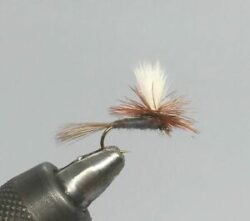Dry fly fishing is simply amazing. Watching a fish slowly rise to the surface and sip a small dry fly is the best. Many fly fishermen only fly fish when they can use dry flies. Sadly, fish tend to feed on dry flies less than 10% of their lives, so a good fly fisherman has several other Superflys in their fly boxes.
The Parachute Adams may be the greatest Dry Superfly. There are hundreds of other dry fly choices, but I bet every Dry fly fisherman, worth their salt, has this fly in their vests.
You can tie an Adams dry fly traditionally, with a full circle of vertical hackle. It rides high on the water and is reliable. The original Adams dry fly was named after Judge Charles Adams, in Mayfield, Michigan. His friend Leonard Halladay designed the fly to target caddis, mayflies, and midges, in 1922. Brown trout had taken over their local waters and the Adams became a special Brownie buster. Later in 1971, Swisher and Richards advocated “flush floating flies” which led to parachute style versions of all classic dry flies.
Lefty Kreh and other great fishers and tiers showed me the importance of a Crystal Flash post for a Parachute tie. I use Crystal Flash on almost all my dry flies not to attract fish but so I can see the fly. The spiral, reflective fibers of the Crystal Flash can reflect light that is visible, at all angles. Seeing is believing when dry fly fishing. If you cannot identify your specific fly, in the herd of bugs on the water, you don’t know when to set the hook.
Even with an arsenal of Superflys, there is no guarantee that you will catch a fish. Remember to properly dress the fly for perfect floatation. The fly must be positioned within the fish’s cone of vision, at the appropriate moment, without drag and with stealth. No one thing is more important than another.
Keep a selection of Adams in different shades and sizes. The shape, color, and look of an Adams mimics most popular Mayfly patterns that you will encounter. The Parachute version allows the fly to sit in the water, not on it. It floats exactly like the Mayfly if imitates. Traditional Dry Flies ride higher and often get refused. Since fish cannot see colors, darker to lighter shades help to match the hatch. They will mimic most Mayflies, caddis, and midges most of the time.
To tie your own Adams, search YouTube for a video of how-to visual instructions. The video can be stopped, rewound, and repeated until you figure it out. Since most fly fishermen are visual learners, we can learn by seeing, quickly.
Catch a big one!
Montana Grant
For more Montana Grant, hook up at www.montanagrantfishing.com.